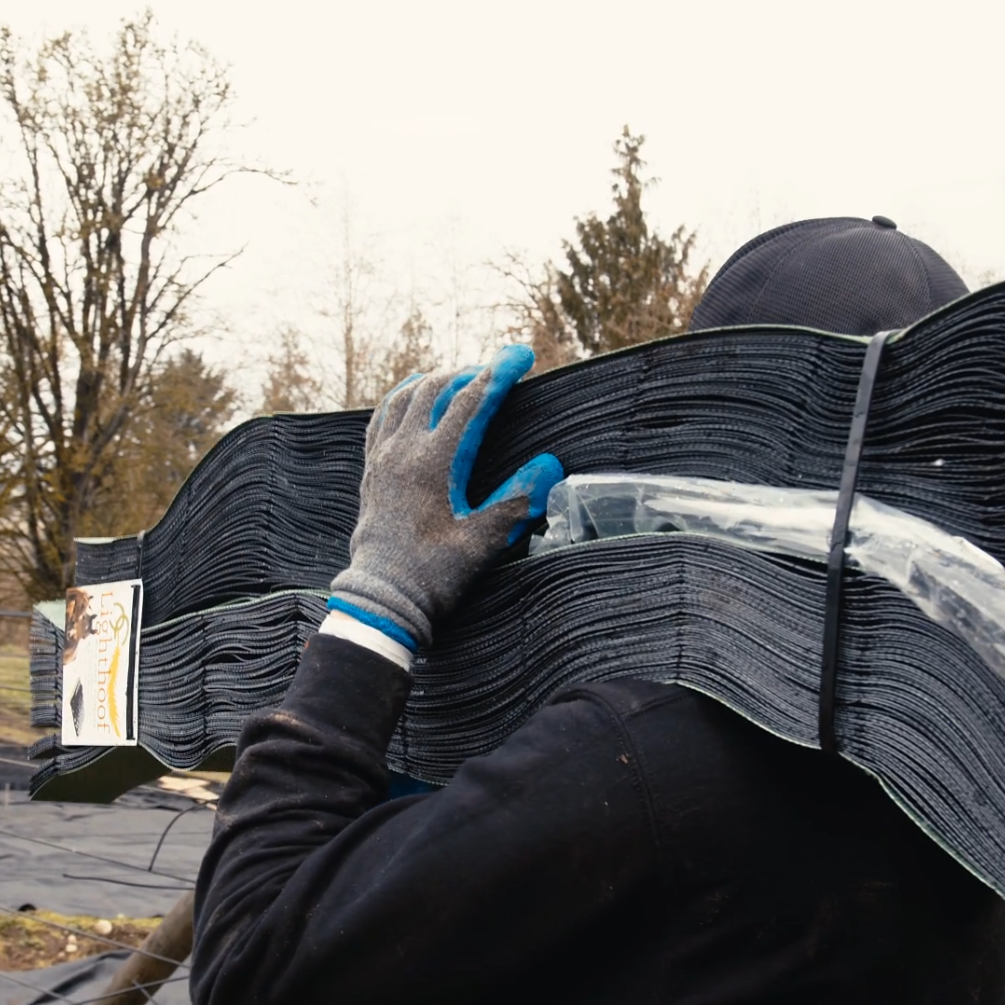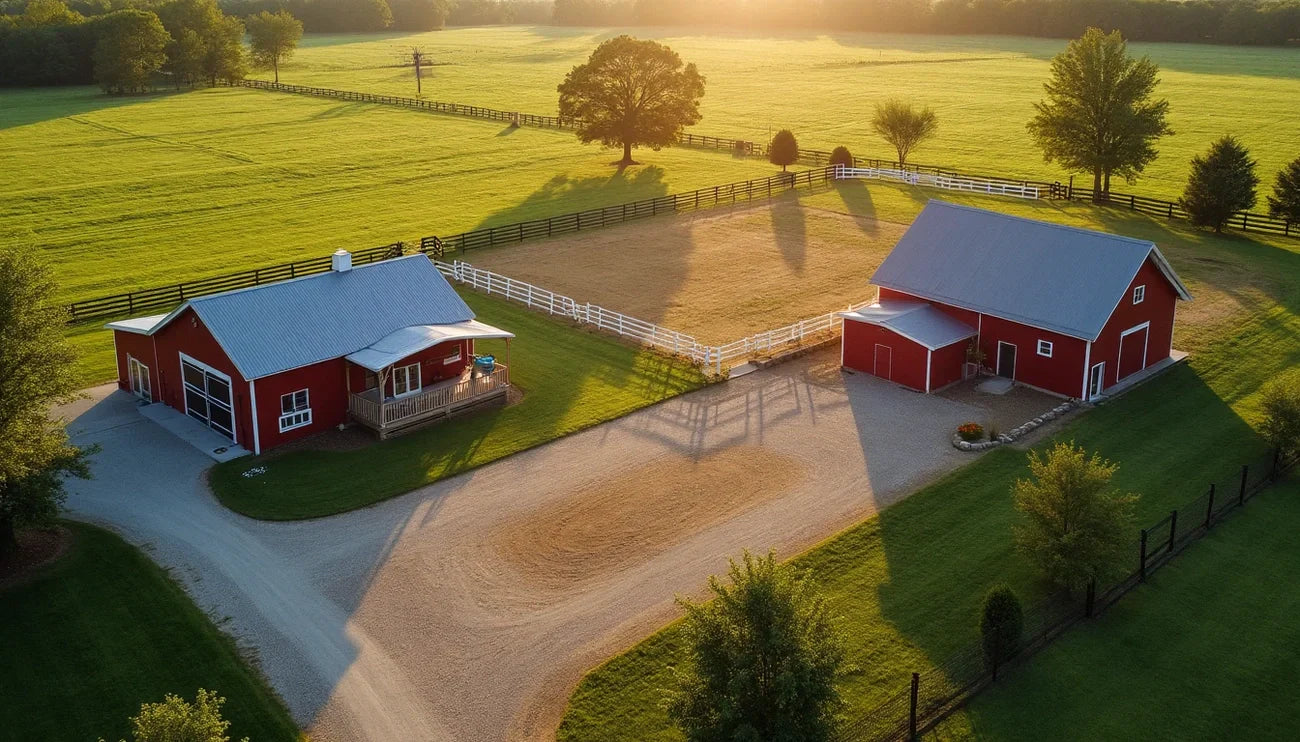Many counties allow you to legally keep one horse per acre [10]. While conventional wisdom suggests 2-3 acres per horse for grazing-only situations [11], horse owners successfully manage their equine companions on smaller properties when they plan effectively.
Making a 2 acre horse farm layout work efficiently requires thoughtful planning and smart design choices. Your compact property can provide everything your horses need while making daily care manageable when you design it correctly.
Proper planning makes the difference between a functional small horse property and one that creates daily headaches. Whether you're navigating zoning requirements that might include variance requests costing around $700 in some areas [10] or creating an efficient layout, the key lies in understanding how to maximize your limited space.
You'll need smart shelter options, daily care strategies, and maintenance solutions specifically designed for smaller properties. When you design your 2-acre horse farm with these considerations in mind, you can create a property that works well for both you and your horses.
Start with Land Assessment and Zoning
Understanding zoning laws and property requirements forms the foundation of any successful 2 acre horse farm layout. Legal compliance varies significantly between regions, making this your essential first step before purchasing property.
Check if Property is Zoned for Horses
Horses on a property previously doesn't automatically mean it's legally approved for equestrian use. Neglecting to verify proper zoning could result in financial penalties or legal issues down the road [13]. Confirm that horses are permitted before planning your efficient 2 acre horse farm layout.
Horses are only allowed in specific zoning classifications in many jurisdictions. Agricultural (A), Rural Residential (RR), or Rural Estate (RE) districts typically permit horses [2]. Some areas explicitly prohibit horses in other zoning categories, regardless of property size.
Contact your local municipality office to determine:
-
Current zoning classification of the property
-
Whether horses are explicitly permitted in that zone
-
If you need special permits for keeping horses
-
Whether you need neighbor approval (some localities require collecting signatures from adjacent property owners) [10]
Don't assume anything, even when a property appears ideal. One horse owner needed to pay approximately $700 for a variance request and present her case to a committee before being allowed to keep horses on her properly zoned land [10].
Understand Building Setbacks and Permits
Setbacks are building restrictions that determine where you can place structures relative to property lines. These requirements vary significantly by location, so you must understand them before construction begins to ensure your 2 acre horse farm layout complies with local ordinances.
Setback requirements include:
-
Stalls must be at least 200 feet from dwellings and 50 feet from property lines [11]
-
Manure and feed storage located at least 400 feet from dwellings and 100 feet from property lines [11]
-
Livestock housing at least 200 feet from neighboring residences [8]
-
Barns with livestock must be minimum 200 feet from all property lines in some counties [10]
Most structures require zoning approval regardless of size. Buildings over a certain square footage (often 256 sq ft or larger) typically require building permits [5]. Working with an architect or land use attorney can help you navigate these complex requirements.
Know How Many Horses Are Allowed
The number of horses permitted on your property is typically determined by acreage, yet these regulations vary dramatically between jurisdictions. Examples include:
-
Some areas follow a simple formula of 1-1.5 acres per horse [6]
-
Others require a minimum of 2 acres for the first horse [2]
-
Some counties allow 3 head of livestock per acre on properties between 1-5 acres [8]
-
More complex formulas exist: "For parcels of three to five acres, three additional horses per acre may be kept" [2]
-
Properties over 5 acres may allow up to 10 head of livestock per acre in some areas [8]
For a 2 acre property specifically, you might be limited to:
-
Just 2 horses (at 1 horse per acre)
-
Up to 6 livestock animals (at 3 per acre) [8]
-
As few as 1 horse (if 2 acres minimum is required for the first horse) [2]
Understanding these requirements is essential for developing a legal and efficient 2 acre horse farm layout. Some municipalities distinguish between private horse keeping and commercial operations, with stricter requirements for boarding facilities or training centers [12].
Smart Layout Planning for 2 Acre Horse Farms
Image Source: Horizon Structures
Creating an effective 2 acre horse farm layout begins with careful planning. Once you've confirmed zoning compliance, designing a space that maximizes functionality while minimizing daily labor becomes your next priority.
Use Scaled Drawings to Plan Layout
Starting with a scaled drawing of your property prevents costly mistakes before you make any physical changes. Visualizing the entire layout helps identify potential issues that could become expensive problems later.
The difference between a mediocre versus well-designed farmette is all in the details [13], particularly when working with limited acreage. Mark existing features on your scaled drawing:
-
Natural drainage patterns and slopes
-
High ground areas ideal for structures
-
Access points for vehicles and equipment
-
Potential paddock divisions and sacrifice areas
Once you add a barn, storage areas, riding ring, trailer parking, and manure storage, the remaining space for pastures becomes surprisingly limited. Every element must be thoughtfully positioned to create an efficient 2 acre horse farm layout.
Keep Barn Close to House for Convenience
Placing your barn within easy viewing distance of your house offers numerous advantages. One experienced horse owner advises, "I would make your sacrifice lot as close to the house as possible actually cause if one is sick you want eyes on them closer than binocular seen." [8]
This proximity provides quick access during emergencies or severe weather. You'll monitor horses more easily without walking long distances, making daily feeding and care routines more efficient while providing better security and peace of mind.
For properties without electric service at the barn, keeping structures close to the house (approximately 200 feet) allows extension of water hoses and other utilities from the main residence [10]. This setup works particularly well for small acreage situations where you're managing just a few horses.
Design for Drainage and Access
Proper drainage is perhaps the most critical factor in creating a sustainable layout 2 acre horse farm. Facility layout is a key first step to permanent drainage solutions [10] that will prevent mud issues and maintain healthy conditions for your horses.
Place all buildings and feeding areas on higher ground with a slope between four and six degrees [10]. This approach ensures fluids flow downward and areas dry faster after rain. When positioning gates, study the land's natural drainage patterns first - installing gates in areas prone to water pooling creates ongoing headaches and access problems [11].
Access planning must accommodate large delivery trucks for feed and bedding, horse trailers for transportation, emergency vehicles if needed, and daily movement between paddocks and barn. Design your farm so large trucks, trailers and emergency vehicles can access all aspects of your property [13].
Gates should be positioned for easy access, as time-consuming trips between areas can disrupt your entire daily schedule [11]. For maximum efficiency, consider placing your round pen, wash rack, and sacrifice area in close proximity to each other and to the barn [8]. This arrangement minimizes walking distances while handling horses and creates a centralized care area within your compact 2 acre horse farm layout.
Shelter and Storage Solutions
Image Source: Fisher Barns
Smart shelter solutions are essential when designing an efficient 2 acre horse farm layout. Every square foot counts on smaller properties, which makes choosing the right structures critical for your success.
Choose Compact Barn Designs
Space-efficient barns maximize your limited area on a 2-acre property. Low-profile horse barns provide an ideal solution for compact spaces, combining efficiency and comfort with a streamlined design [12]. These structures feature reduced roof height and simplified rooflines while maintaining adequate ventilation and comfortable stalls.
Consider these popular compact options for maximum flexibility:
-
Shed row barns: Provide full coverage with minimal footprint, easily customized to your exact number of horses [13]
-
Run-in sheds: Open on one side for horses to enter freely, offering protection with minimal space requirements [13]
-
Mini barns: Designs with 2-4 stalls plus storage, perfect for smaller properties [4]
Property owners have successfully converted existing structures like carports into functional two-stall barns for truly limited spaces [4]. Rather than building new, renovating existing structures can save money while providing custom solutions tailored to your specific needs.
Use Feed Rooms Efficiently
The feed room deserves thoughtful planning despite lacking the "wow factor" of a spectacular arena or viewing lounge [3]. Efficient operation requires careful attention to key elements that make daily feeding routines smoother.
Position your feed room for easy access, ideally with two doors: one opening into the barn and another on an outside wall for direct feed deliveries [3]. This arrangement minimizes disruption to your horses while simplifying restocking procedures.
Prevent mold growth and feed spoilage by installing windows that open or a ventilation system to maintain air circulation [3]. Proper insulation helps regulate temperature and humidity, which significantly affects feed quality over time.
Use metal bins or tightly sealed plastic containers to repel pests and moisture [3]. Label all containers clearly with feed type and expiration dates. Many owners use sturdy rubberized garbage bins lined against one wall as an affordable, practical solution that works well in compact spaces.
Store Tack in Trailers or Garages
Limited barn space on a 2-acre property makes creative tack storage necessary. Unlike larger farms, compact properties often can't dedicate precious barn space exclusively for tack storage.
Alternative storage solutions that work well include:
-
Using your horse trailer as a mobile tack room when not in transit
-
Converting a section of your garage with specialized racks and cabinets
-
Installing metal cabinets that keep items tidy and dust-free [14]
Metal cabinets offer excellent protection against rodents—a crucial consideration since mice attracted to feed storage might find leather tack equally appetizing [15]. Keeping tack and feed separated prevents unwanted damage to expensive equipment while maintaining organization in your compact facility.
Feeding, Watering, and Daily Care
Image Source: Facebook
Proper feeding and watering systems form the backbone of any functional horse property. On compact 2-acre farms, efficiency becomes even more important for daily management.
Install Hay Feeders and Water Tanks
Hay feeders reduce waste by 30-40% compared to ground feeding [16], making them essential for efficient feed management on smaller properties. Choose feeders with deep, curved designs to prevent spillage and position them on level ground in well-drained locations. Slow feeders or hay nets extend foraging time while preventing overconsumption [17].
Water access requires careful planning since horses need 5-15 gallons daily [1]. Install multiple water sources throughout your property to ensure consistent access. Place troughs in paddocks for outdoor access and buckets in stalls for overnight hydration. Include backup water options in case primary sources fail.
Check water sources daily and remove debris that might discourage drinking [1]. Clean water encourages proper hydration and supports overall horse health.
Use Heated Buckets in Winter
Winter hydration presents unique challenges since horses consume more water when it's tepid rather than freezing [18]. The American Association of Equine Practitioners identifies lack of unfrozen water as the number one cause of winter colic [18].
Install heated buckets only in ground-fault circuit interrupter (GFCI) outlets to prevent electrical hazards [19]. Quality heated buckets feature thermostat controls that activate around 30°F and deactivate at 40°F, maintaining water temperatures between 50-60°F without wasting energy [18].
Keep Feed Close to the House
Position feed storage near your residence to streamline daily care routines. This arrangement ensures easier monitoring and reduces labor during harsh weather, similar to keeping your barn accessible.
Proximity allows for consistent morning and evening feeding schedules when offering hay, topping off water, and providing grain supplements [20]. This setup also helps you observe your horses' eating patterns more easily, which is important for detecting early signs of health issues [21].
Utilities, Maintenance, and Safety
Maintaining a functional 2 acre horse farm layout requires thoughtful planning for utilities, waste management, and safety measures. These elements determine how smoothly your daily operations run on limited acreage.
Use Battery Lights if No Electricity
Small properties without access to grid power need alternative lighting solutions to keep your barn functional after dark. Solar lighting systems provide illumination with minimal installation hassle and virtually no maintenance beyond occasional battery replacement. These systems include energy storage capabilities, allowing you to bank generated power for evening use.
Biogas digesters offer another option, transforming animal waste into methane-rich fuel that powers specially designed lamps. These systems capture 15-20 cubic feet of biogas daily from just 25 pounds of manure, providing 4-6 hours of bright, sustainable lighting [7]. For emergency situations, hand-crank lanterns deliver 30-45 minutes of bright LED illumination from just 1 minute of cranking [7].
Plan for Manure Removal or Composting
One horse produces approximately 50 pounds of manure daily and more than eight tons annually [9]. Horses also generate 8-10 gallons of urine daily [9]. Proper waste management becomes crucial for an efficient 2 acre horse farm layout when you consider these figures.
Locate manure piles far from water sources to prevent contamination. Cover storage areas with tarps or roofing during rainy seasons to prevent nutrient runoff. Compost manure whenever possible to create valuable soil amendments—the annual manure from one horse has a compost value between $300-$500 [9].
Proper composting requires maintaining adequate moisture (about as damp as a wrung-out sponge) and ensuring sufficient oxygen [9]. To kill parasites and pathogens, compost needs to reach at least 130°F for a minimum of three days [9].
Fence Off Trees and Remove Toxic Plants
Regular inspection of your entire property forms the foundation of equine safety. Fence completely around trees to prevent horses from stripping bark [22]. Fence around utility poles and guy wires to eliminate hazards [22].
Check fences by walking or driving the lines regularly, promptly repairing any broken or loose sections [22]. Toxic trees that should be removed or fenced off include:
-
Yew trees (highly toxic with as little as 0.5 lb being lethal)
-
Red maple (wilted leaves are highly toxic)
-
Cherry, peach, and plum trees (contain cyanide when wilted)
-
Black walnut (bark and nut hulls are toxic)
Walk pastures periodically to identify and remove poisonous plants, checking at least 3-4 feet beyond fence lines where horses often stretch for forage [23].
Conclusion
Creating an efficient 2 acre horse farm layout requires thoughtful planning and smart design choices. Even limited acreage can provide everything your horses need when you organize it properly.
Understanding zoning laws remains essential before you purchase property or make improvements. Requirements vary significantly between jurisdictions, potentially limiting the number of horses allowed and dictating building placement. Careful assessment of your land's natural features helps you position structures optimally and prevents costly mistakes.
Smart layout planning determines how functional your small farm becomes. Keep your barn close to your house, position structures on high ground, and ensure proper access for vehicles. This creates a property that works with you rather than against you. Compact barn designs and creative storage solutions maximize your limited space while meeting all your horses' needs.
Daily care becomes manageable when you integrate feeding, watering, and maintenance systems thoughtfully. Hay feeders reduce waste, heated buckets ensure winter hydration, and proper manure management keeps your small property clean. Implementing safety measures like fencing off hazardous trees and removing toxic plants protects your horses.
The success of your 2 acre horse farm depends not on its size but on the intelligence of its design. Well-planned small properties provide excellent equine care while remaining manageable for owners. Apply these practical solutions specifically tailored for compact spaces, and you'll create an efficient, functional horse property that serves both you and your horses well for years to come.
References
[1] - https://www.queencityequestrian.com/blog/living-with-horses-on-under-3-acres
[2] - https://paddockblade.com.au/blogs/paddock-blade-blog/best-horse-paddock-layout-tips-for-every-farm?srsltid=AfmBOorQl6_5A58YO00dMRO77-Bm8aIWgdAAIN4XTcbiNDYll_jtg31J
[3] - https://www.landapp.com/post/tips-for-purchasing-a-horse-property
[4] - https://www.suffolkva.us/FAQ.aspx?QID=208
[5] - https://codelibrary.amlegal.com/codes/richlands/latest/richlands_nc/0-0-0-4204
[6] - https://www.harmonyrealtytriangle.com/urban-farming-in-raleigh/
[7] - https://www.spotsylvania.va.us/Faq.aspx?QID=501
[8] - https://fairwaystables.com/equine/equine-law/setback-laws-for-horse-farms/
[9] - https://www.trianglehousehunter.com/horse-farms-for-sale-raleigh-durham-chapel-hill/
[10] - https://horsemansnews.com/laying-out-your-small-horse-farm/
[11] - https://www.horseforum.com/threads/potential-layout-of-new-property.818173/
[12] - https://extension.umn.edu/horse-pastures-and-facilities/managing-mud-horse-farms
[13] - https://paddockblade.com.au/blogs/paddock-blade-blog/best-horse-paddock-layout-tips-for-every-farm?srsltid=AfmBOopYnr3_JOGEHchSZj0_7J_Pd9JuB-H2kEfTHXvlZZcTGhSrGvhW
[14] - https://ncsbarns.com/low-profile-horse-barns-ideal-solutions-for-compact-spaces/
[15] - https://www.glicksheds.com/blog/barns/shop-our-mini-horse-barn-options
[16] - https://stablestyle.net/10-small-horse-barns/
[17] - https://horsesport.com/magazine/equine-ownership/organizing-your-feed-room/
[18] - https://forums.horseandhound.co.uk/threads/creative-tack-room-storage-ideas-please.773974/
[19] - https://fisherbarns.com/blog/horse-barn-designs-and-plans/?srsltid=AfmBOoojYrqMy23irI-6RQcWDRFx4g8dWxoAiLdHmtFFOm-PNucz2LZp
[20] - https://www.horizonstructures.com/save-money-hay-easy-way/
[21] - https://madbarn.com/diy-hay-feeders-for-horses/?srsltid=AfmBOorOTG_6aLAr069PsTJZyL_ouRo4DuFv9SBbj9_wRd0gKpUvohsz
[22] - https://madbarn.com/basic-horse-care-guide/?srsltid=AfmBOoplDY-fbxTF6OrA4M1g6bdS4_V9qeJYw0x35eBwvxZVUx0ncUjJ
[23] - https://cascadaequine.com/blogs/news/using-heated-water-buckets-for-your-horse-s-winter-care
[24] - https://americanstalls.com/blogs/blog/6-essential-safety-tips-for-using-heated-water-troughs-and-buckets-in-the-winter?srsltid=AfmBOorZ-0ED-_NtvS_SUD5wAD9M6hJ8KWryMQmzq5zO-KWdYVm93HHR
[25] - https://mynewhorse.equusmagazine.com/2025/04/14/what-does-a-daily-horse-care-routine-look-like/
[26] - https://www.budgetequestrian.com/getting-your-horse-property-ready-a-guide-to-bringing-your-equine-companion-home/
[27] - https://www.farmstandapp.com/66394/7-best-sustainable-lighting-options-for-off-grid-farms/
[28] - https://thehorse.com/17205/9-steps-for-composting-horse-manure/
[29] - https://ker.com/equinews/safe-horses-require-safe-fences/
[30] - https://njaes.rutgers.edu/fs938/






Leave a comment
This site is protected by hCaptcha and the hCaptcha Privacy Policy and Terms of Service apply.